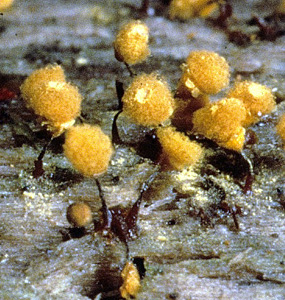Hemitrichia calyculata

Image Courtesy of Eleanor Yarrow
| Click to Enlarge |
| Click For Image Gallery |
|
Group of Fungi: Slime Molds Family: Trichiaceae Latin Name: Hemitrichia calyculata (Speg.) M. L. Farr Common Name: None Description: Turbinate to globose structure, 1/16–1/8 in (0.15–0.3 cm) high and 1/32–1/16 in (0.1–0.15 cm) wide on a tiny stalk, bright to dark yellow; stalk less than one-half the total height, reddish brown to black, expanded at the top to form a distinct funnel-shaped cup; spores dull yellow in mass and located within a fuzzy mass of very small yellow threads. Biological Role: The vegetative stage (called a plasmodium) in the life cycle of this organism feeds upon the bacteria associated with decaying plant material. Habitat: On decaying wood or (less commonly) bark in broadleaf or conifer forests; occurring in small or large groups. Geographical Distribution: Found throughout the world but more common in tropical than temperate regions of the world. Comments: The slime molds are not true fungi but are found in many of the same situations. Hemitrichia calyculata is one of the more common slime molds, and it is usually relatively easy to spot in the field because of the bright yellow color of the fruiting bodies. |
| Go Back |